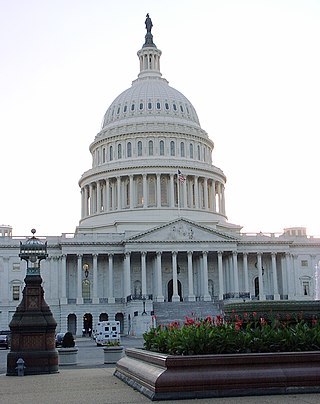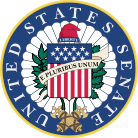
The 108th United States Congress was a meeting of the legislative branch of the United States federal government, composed of the United States Senate and the United States House of Representatives from January 3, 2003, to January 3, 2005, during the third and fourth years of George W. Bush's presidency.

The 106th United States Congress was a meeting of the legislative branch of the United States federal government, composed of the United States Senate and the United States House of Representatives. It met in Washington, D.C., from January 3, 1999, to January 3, 2001, during the last two years of Bill Clinton's presidency. The apportionment of seats in the House of Representatives was based on the 1990 United States census. Both chambers maintained a Republican majority.

The 104th United States Congress was a meeting of the legislative branch of the United States federal government, composed of the United States Senate and the United States House of Representatives. It met in Washington, D.C. from January 3, 1995, to January 3, 1997, during the third and fourth years of Bill Clinton's presidency. Apportionment of seats in the House of Representatives was based on the 1990 United States census.

The United States Senate Committee on Appropriations is a standing committee of the United States Senate. It has jurisdiction over all discretionary spending legislation in the Senate.

The Committee on Agriculture, Nutrition, and Forestry is a committee of the United States Senate empowered with legislative oversight of all matters relating to the nation's agriculture industry, farming programs, forestry and logging, and legislation relating to nutrition, home economics, and rural development.

The Committee on Armed Services, sometimes abbreviated SASC for Senate Armed Services Committee, is a committee of the United States Senate empowered with legislative oversight of the nation's military, including the Department of Defense, military research and development, nuclear energy, benefits for members of the military, the Selective Service System and other matters related to defense policy. The Armed Services Committee was created as a result of the Legislative Reorganization Act of 1946 following the U.S. victory in World War II. The bill merged the responsibilities of the Committee on Naval Affairs, established in 1816, and the Committee on Military Affairs, also established in 1816.

The United States Senate Committee on Commerce, Science, and Transportation is a standing committee of the United States Senate. Besides having broad jurisdiction over all matters concerning interstate commerce, science and technology policy, and transportation, the Senate Commerce Committee is one of the largest of the Senate's standing committees, with 28 members in the 117th Congress. The Commerce Committee has six subcommittees. It is chaired by Sen. Maria Cantwell (D-WA) with Sen. Ted Cruz (R-TX) as Ranking Member. The majority office is housed in the Dirksen Senate Office Building, and the minority office is located in the Hart Senate Office Building.

The United States Senate Committee on Finance is a standing committee of the United States Senate. The Committee concerns itself with matters relating to taxation and other revenue measures generally, and those relating to the insular possessions; bonded debt of the United States; customs, collection districts, and ports of entry and delivery; deposit of public moneys; general revenue sharing; health programs under the Social Security Act and health programs financed by a specific tax or trust fund; national social security; reciprocal trade agreements; tariff and import quotas, and related matters thereto; and the transportation of dutiable goods. It is considered to be one of the most powerful committees in Congress.

The United States Senate Committee on Homeland Security and Governmental Affairs is the chief oversight committee of the United States Senate. It has jurisdiction over matters related to the Department of Homeland Security and other homeland security concerns, as well as the functioning of the government itself, including the National Archives, budget and accounting measures other than appropriations, the Census, the federal civil service, the affairs of the District of Columbia and the United States Postal Service. It was called the United States Senate Committee on Governmental Affairs before homeland security was added to its responsibilities in 2004. It serves as the Senate's chief investigative and oversight committee. Its chair is the only Senate committee chair who can issue subpoenas without a committee vote.

The United States Senate Committee on Banking, Housing, and Urban Affairs, also known as the Senate Banking Committee, has jurisdiction over matters related to banks and banking, price controls, deposit insurance, export promotion and controls, federal monetary policy, financial aid to commerce and industry, issuance of redemption of notes, currency and coinage, public and private housing, urban development, mass transit and government contracts.

The United States Senate Committee on Environment and Public Works is responsible for legislation and oversight of the natural and built environment and for studying matters concerning environmental protection and resource conservation and utilitization.

The Senate Committee on Rules and Administration, also called the Senate Rules and Administration Committee, is responsible for the rules of the United States Senate, administration of congressional buildings, and with credentials and qualifications of members of the Senate, including responsibility for contested elections. The committee is not as powerful as its House counterpart, the House Committee on Rules, as it does not set the terms of debate for individual legislative proposals, since the Senate has a tradition of open debate. Some members of the committee are also ex officio members of the Joint Committee on the Library and the Joint Committee on Printing.

The Senate Committee on Indian Affairs is a committee of the United States Senate charged with oversight in matters related to the American Indian, Native Hawaiian, and Alaska Native peoples. A Committee on Indian Affairs existed from 1820 to 1947, after which it was folded into the Committee on Interior and Insular Affairs. A new Native Affairs Committee was created in 1977, initially as a select committee, as a result of the detachment of indigenous affairs from the new Committee on Energy and National Resources, which had succeeded the old Committee on Interior and Insular Affairs. The committee was initially intended to be temporary, but was made permanent in 1984. The committee tends to include senators from Western and Plains states, who have more Native American constituents.

The 98th United States Congress was a meeting of the legislative branch of the United States federal government, composed of the United States Senate and the United States House of Representatives. It met in Washington, D.C., from January 3, 1983, to January 3, 1985, during the third and fourth years of Ronald Reagan's presidency. The apportionment of seats in the House of Representatives was based on the 1980 U.S. census.

The United States Senate Committee on the Budget was established by the Congressional Budget and Impoundment Control Act of 1974. It is responsible for drafting Congress's annual budget plan and monitoring action on the budget for the Federal Government. The committee has jurisdiction over the Congressional Budget Office. The committee briefly operated as a special committee from 1919 to 1920 during the 66th Congress, before being made a standing committee in 1974.

The standing Committee on Veterans' Affairs in the United States House of Representatives oversees agencies, reviews current legislation, and recommends new bills or amendments concerning U.S. military veterans. Jurisdiction includes retiring and disability pensions, life insurance, education, vocational training, medical care, and home loan guarantees. The committee oversees the Department of Veterans Affairs (VA), veterans' hospitals, and veterans' cemeteries, except cemeteries under the Secretary of the Interior.

The Committee on Education and the Workforce is a standing committee of the United States House of Representatives. There are 50 members of this committee. Since 2023, the chair of the Education and the Workforce committee is Virginia Foxx of North Carolina.

The 109th United States Congress was a meeting of the legislative branch of the United States federal government, composed of the United States Senate and the United States House of Representatives, from January 3, 2005, to January 3, 2007, during the fifth and sixth years of George W. Bush's presidency. House members were elected in the 2004 elections on November 2, 2004. Senators were elected in three classes in the 2000 elections on November 7, 2000, 2002 elections on November 5, 2002, or 2004 elections on November 2, 2004. The apportionment of seats in the House of Representatives was based on the 2000 United States census.

The Public Safety Employer-Employee Cooperation Act of 2007, introduced in the 110th Congress(H.R. 980, S. 2123), proposed to establish minimum standards for state collective bargaining laws for public safety officers.








